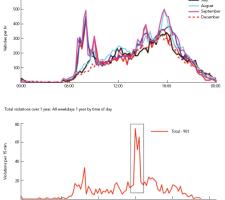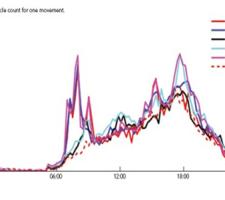
Road authorities have a lot to gain from high-resolution traffic data, argues Pravin Varaiya.
Traffic engineers have traditionally been forced to operate with limited data regarding the performance of their arterials. Traffic studies are often commissioned once every three years, over a few days, to get an updated estimate of utilization. These “snapshot” datasets are used for a variety of management decisions, including signal timing. Operators understand all too well the limitation of such an approach, but with limited funding, are forced to settle for “good enough” data. A new generation of wireless vehicle detection systems has now made it economical to capture ongoing data, 24x7, including high resolution data. In this article we examine the merits of such high resolution data systems.
A high resolution data system for an intersection captures the location (lane), speed, and turn movement of every vehicle as it approaches and departs an intersection, together with the signal phase. The data is available in real time and archived. Real-time data is used to implement traffic-responsive signal control, including adaptive signal control. Archived data is used to obtain intersection, corridor, and network performance, and to evaluate and design better control strategies.
Real world impact of high resolution data
Intersections are where high resolution data systems can make the biggest difference in terms of congestion mitigation and safety improvement. Take for example an intersection in Danville, CA. From vehicle departures during each phase we can measure the saturation flow rate for that phase. Hence we can accurately calculate the volume to capacity (VC) ratio for each phase: VC Ratio = Count / Green time x Saturation rate.
Figure 1 displays the VC ratios for two (out of six) phases over one day in 15-min intervals, together with the level of service (LOS). The plot of Phase 4 shows the impact of the pickup times of the school near the intersection. The two plots immediately suggest “transferring” some green time from Phase 8 to Phase 4 around 5pm to improve LOS of Phase 4 from C, while maintaining the LOS at Phase 8 within A.
In most cities timing plans are revised every few years based on count data collected over two to three days. For communities where traffic patterns are consistent throughout days of the week and months of the year, this limited data set can be acceptable. But in areas where traffic fluctuates due to school schedules and special events or in redeveloping and growing communities where traffic patterns are evolving, that snapshot of data does not provide the full picture for informed traffic management decisions such as signal re-timing.
Figure 2 shows for a particular movement the median 15-min counts over Tuesday, Wednesday and Thursday for six months. There is a large increase in counts at 8am and 9pm during February, March and September and a dramatic reduction in July, August and December when a nearby school is not in session. Clearly, this intersection should have different timing plans for those three months. Traffic measurement during a single week would not reveal this need.
Just as the traffic varies from month to month, so does it varies from week to week and within the same day of the week. A traffic plan that adapts to these intra-day changes would provide better performance. This is illustrated in Figure 3. The plot on the left is the delay per vehicle at the intersection, averaged every 15-min from 6:15-9:45am over three successive Tuesdays, and estimated from actual measurements.
The plot on the right is the percent reduction in the delay when the plan is re-timed every 15-min based on the measured data. Even this simple adaptive traffic control reduces delay by 5 to 20%. But like any adaptive scheme, it relies on continuous measurements, and cannot be implemented using non-real time traffic snapshots collected several times each year.
Note that any intersection with actuated traffic control has vehicle detectors that can provide most of the high resolution data. However, this data is not stored at the fine time resolution with which they are generated, nor are they available in a form for use by adaptive control schemes or for safety applications.
From the high resolution data one can determine in real time when a vehicle violates a red light, makes a right turn without stopping or speeds through the intersection. These are all hazardous events that can lead to injuries. Figure 4 plots red light violations by time of day over one year. There is a high violation rate shortly after 3PM, when the school lets out. Authorities could encourage drivers to drive more carefully by having police present for one or two weeks, accompanied by an advertising campaign. How well such an educational campaign is succeeding can be gauged in a few weeks from the violation data. The Danville intersection has several red-light violations at high speed within 1.5s of the end of yellow, which suggests that these drivers are placed in a yellow interval dilemma zone.
A video camera installed at the intersection could be triggered to capture red-light violations. Figure 5 shows three frames that capture a red-light violator causing a near crash.
Connected vehicles
High resolution data can help realise the potential of connected vehicles to improve mobility. The saturation flow rate of an intersection is about 1,500 vehicles per hour, or one vehicle every 2.4s, implying that after the light turns green it will take 36s for a 15-vehicle queue to enter the intersection. High resolution measurements at an intersection in Santa Clarita show, however, that this queue can take as much as 56s, because each driver accelerates with a short time delay after the preceding vehicle moves. If the traffic controller signals to the queued connected vehicles that the light will turn green in (say) 2 sec, all 15 vehicles could move as a platoon. Assuming 40’ per vehicle in the platoon and a speed of 30mph (44 feet/sec), the 15-vehicle platoon would enter the intersection in 13.6s, compared with the theoretical 36s and the observed 56s. This is a dramatic increase in the saturation flow by a factor of three or four. Figure 6 is a schematic of the system of vehicle detectors installed at an intersection in Santa Clarita, CA. Each tiny white dot is a magnetic sensor that reports the times at which a vehicle enters and leaves its detection zone. When there is a pair of detectors, like at every stop bar and some advanced locations, the speed of the vehicle is also estimated and reported. The sensors send their reports via radio to a gateway (Access Point) located at the controller, which also sends the signal phase. The gateway can also accommodate a Bluetooth or Wi-Fi reader which records the anonymized MAC address of Bluetooth or Wi-Fi equipped electronics in the vehicle. These MAC addresses can be matched to provide link travel times and construct origin-destination patterns. Combined with the high resolution intersection data, one can estimate vehicle miles travelled (VMT) and vehicle hours travelled (VHT) over an urban network. These critical metrics are not available from probe vehicle data alone.
Conclusion
In the absence of continuous traffic monitoring, neither operators nor the public can determine how bad traffic conditions are or how much improvement is possible. “If you don’t know what’s happening on your roads, don’t expect to manage the traffic well” is a truism. A high-resolution data system provides 24x7 continuous measurements of every vehicle’s speed and location as it enters an intersection. The real-time data can be used to improve both mobility and safety. Archived data can be used to evaluate performance and to design and evaluate traffic control strategies. High resolution data systems forever end the operator’s need to settle for “good enough” data, and will transform the way urban networks are managed.
About the author
- Pravin Varaiya, is Emeritus professor of the Graduate School, Electrical Engineering and Computer Science at the University of California, Berkeley.














